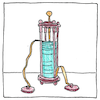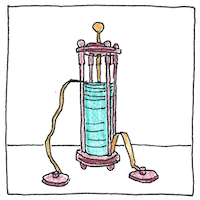Alessandro Volta
electromagnetism

|
Electric battery
We name the unit of electric potential the ‘volt’ to honor Alessandro Volta because he created the voltaic pile the first electric battery. Scientists already had the electrophorus and the Leyden jar, devices that produce and store a static electrical charge. Now, for the first time, scientists had a continuous source of electricity to study.
Luigi Galvani
Luigi Galvani was trying to prove that a frog’s testicles were in its legs and accidentally twitched a muscle when his steel scalpel touched the brass hook that held the leg in place. Galvani interpreted this accident as an instance of animal electric fluid conducted by the scalpel from the muscle to the nerve. Volta realized that the electricity could be created without the frog, which he replaced with a piece of paper soaked in brine. Volta coined the term ‘galvanic cell’ to honor his friend Galvani describing an electrochemical cell in which two plates of different metals separated by an electrolyte produce electricity.
It didn’t just happen
Before Luii showed Alessandro his twitching frog leg Alessandro had already done an experiment. He had put a coin of one metal under his tongue and another coin of a different metal on top of his tongue. When he connected the two coins with a wire the coins tasted salty.
Remote control
Without the frog muscles can still be made to twitch and pistols can still be fired from the other end of a wire. Soon enough, performances and sports events would be created for only remote viewers who would be given only token control.



It didn’t just happen. Volta had experimented with static electricity for years. In 1775 he had improved and named the electrophorus. In 1775 and 1776 he studied methane from marshes and found that an electric spark could ignite it.
Volta demonstrated a remotely operated pistol, using a Leyden jar in Como to fire a pistol at the other end of a copper wire in Milan, fifty kilometers away.
Napoleon made Volta a count in 1810.
See also in The book of science:
You can read more about Volta and Galvani, and about how to make electric batteries: